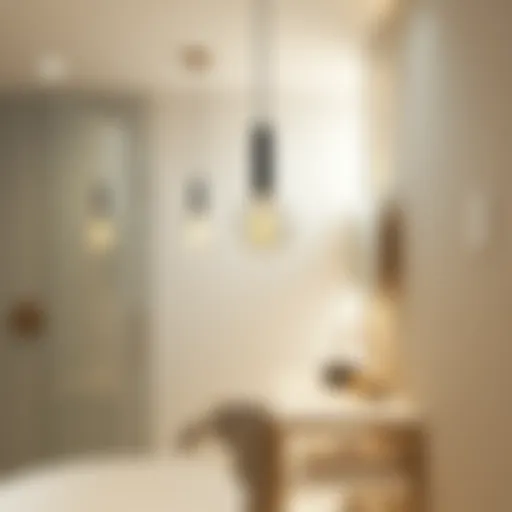Expert Tips for Choosing Matching Sofas


Intro
Selecting the right sofa can feel like an uphill battle. After all, it’s not just about finding a piece of furniture that looks good; it’s about creating a cozy environment that speaks to your personal style while complementing the rest of your home. This guide aims to ease that process, offering various insights into choosing the perfect matching sofas. Whether you’re a homeowner looking to refresh your living room or a design enthusiast eager to stay updated on the latest trends, you’ll find the information here invaluable.
Let’s dig into the nitty-gritty - from current design trends reshaping the way we think about sofas to practical purchasing tips that can save you both time and money.
Design Trends
Current Trends in Furniture Styles
In recent years, we’ve noticed a palpable shift in furniture aesthetics. Minimalistic designs have taken a back seat to more diverse styles, emphasizing comfort without sacrificing looks. Think of mid-century modern with its iconic wooden legs, or the ever-popular Scandinavian style that effortlessly combines functionality with minimal ornamentation. These designs not only create a welcoming atmosphere but also offer a timeless feel that can adapt to changing preferences.
Color palettes have also shifted, with neutral tones like beige and gray setting the stage, while pops of vibrant colors—think mustard yellows or emerald greens—add life to the space. Textures play a hugely important role in this evolution. Velvet sofas, for example, bring a touch of luxury, while woven fabrics can offer a cozy vibe.
How to Incorporate Trends into Your Space
To incorporate these trends effectively, consider the overall theme of your living area. For a more relaxed environment, choose a plush, oversized sectional in a muted color and pair it with soft textiles like chunky knits and natural fiber throws. If you're leaning toward a chic, elegant vibe, opt for a sleek, tailored silhouette wrapped in rich green velvet, paired with metallic accents.
When integrating new pieces, think about harmony. A bold statement piece should align with your existing furnishings and decor while enhancing the overall feel of the room. As you select pieces, consider not just how they look on their own, but how the colors and textures will interplay with each other.
"Good design is in the details. Consider how shadows and forms interact in your space, and select pieces that create a dialogue."
Buying Guides
Choosing the Right Furniture for Different Rooms
A one-size-fits-all approach doesn’t apply when it comes to selecting sofas for various rooms. Each space has its own unique requirements and functions. For instance, in a living room, blend comfort with style to accommodate family gatherings as well as entertaining. Opt for deeper cushions and durable fabrics that can stand up to everyday wear.
In a more formal setting, like a guest room, a stylish love seat with a chic fabric can serve dual purposes. It offers a cozy spot for guests but doesn’t overwhelm the room. Lastly, consider smaller spaces, like an office nook or reading corner, where compact yet comfortable options like chaise lounges can maximize functionality without compromising aesthetics.
Tips for Assessing Quality and Value
Investing in a quality sofa means scrutinizing it from every angle. Check the frame: hardwood frames tend to be more durable than cheaper materials. Look closely at the upholstery—natural fibers like cotton or linen often provide a different feel than synthetic materials. Test the cushions; they should be firm yet comfortable, supporting you without sagging too quickly.
When in doubt, do a little research. Reading reviews on websites like Reddit or checking out guides on platforms like Britannica can offer further insights into reputable brands and models. Additionally, pay attention to warranties and return policies as these factors can indicate the manufacturer's confidence in their product's durability.
Overall, this guide aims to empower you with knowledge. Choosing a sofa isn’t just a purchase; it’s a step toward enhancing your living environment. Navigate through styles, assess quality, and you will undoubtedly find a match that brings comfort and joy to your home.
Preface to Matching Sofas
Selecting the right sofa can seem like a daunting task, yet its importance cannot be overstated. Sofas constitute a central piece in home décor; they serve as a visual anchor in the living space while providing comfort and functionality. Choosing a matching sofa not only uplifts the appearance of the room but also enhances your lifestyle. Its selection is crucial as it reflects your style and creates a warm, inviting ambiance for both you and your guests.
Importance of sofa selection
When it comes to furnishing your home, a sofa is typically the largest investment you'll make in terms of both space and money. A mismatched sofa can disrupt the flow of your décor, even if other elements in the room are perfectly coordinated. Think about it: you wouldn’t want a stunning, sleek modern coffee table sitting alongside a bulky, old-fashioned sofa. This contrast can create discord in your living space, undermining any effort you’ve put into the overall design.
Selecting the right sofa involves considering style, comfort, and functionality. It’s essential to evaluate how often your sofa will be used. Are you an entertainer, hosting frequent gatherings? Or perhaps a family person with kids who love to jump around? Sofas built for durability, easy cleaning, and long-lasting comfort become paramount under such circumstances.
“A well-chosen sofa acts like a canvas; it can set the tone for the entire room.”
How matching sofas influence room aesthetics
The aesthetic appeal of your room significantly hinges on the sofas you choose. A well-matched sofa has the power to unify disparate elements in your décor. Whether it’s the color palette of the walls, the wood tones of the furniture, or the textiles of curtains and cushions, a sofa that complements these features can bring harmony and sophistication.
When selecting colors, consider the mood you wish to evoke. Sofas in neutral colors can offer versatility, allowing you to switch up accessories without needing to replace your furniture. On the other hand, a bold, statement sofa can serve as a focal point, drawing the eye immediately as you enter the space. Moreover, textures play a pivotal role in this visual narrative; a plush velvet couch, for example, can add a sense of luxury, whereas a linen sofa feels refreshingly casual.
In summary, the selection of matching sofas is not only about picking a piece for comfort but also about creating an appealing visual flow in your space. Paying attention to how it blends with the entire room can lead to a sophisticated and harmonious atmosphere that speaks volumes about your style and taste.
Understanding Sofa Styles
When it comes to selecting matching sofas, understanding different sofa styles is crucial. The style of your sofa sets the mood for the entire room, influencing how the space feels and functions. Whether you're aiming for a cozy, traditional vibe or a sleek, contemporary look, knowing the styles available will steer your decision-making process.
A well-chosen sofa not only complements your existing decor but also reflects your personal taste. Additionally, selecting the right style can maximize the utility of your space. It’s more than just aesthetics—practicality plays a huge role here, especially for homeowners with families or pets. If you have children or pets running around, a style that's durable yet sophisticated would be ideal.
Furthermore, understanding the variations within each sofa style allows you to mix and match effectively, creating a harmonious space that doesn't feel chaotic. For homeowners, designers, and DIY enthusiasts, this knowledge can ignite creativity while ensuring functionality remains in focus.
Contemporary vs. Traditional sofas
Contemporary and traditional sofas represent two contrasting approaches to interior design. Traditional sofas often feature classic designs, elaborate details, and rich textures, like plush fabrics and ornate trims. They evoke a sense of timeless luxury and can often create a warm, inviting atmosphere suitable for formal settings.
On the other hand, contemporary sofas embrace minimalism, sleek lines, and often feature bold colors or unique materials. They tend to be more versatile, fitting seamlessly into various design schemes from urban lofts to modern suburban homes.
"Choosing between traditional and contemporary should not just focus on preferences; it’s essential to consider your living space, existing furniture, and overall aesthetic that you wish to achieve."
In summary, traditional sofas lend a historic ambiance, while contemporary styles offer flexibility and a fresh appearance. The choice between them hinges on the personality of your space and the mood you want to foster.
Transitional designs: The best of both worlds


Transitional sofas present an interesting middle ground. They marry the comfort and elegance of traditional pieces with the clean lines of contemporary designs. This style allows homeowners to maintain a balance, making it a popular choice for those who appreciate elements of both worlds without being tied down to a single aesthetic.
Transitional designs often feature soft silhouettes and neutral tones, which makes them adaptable to different environments. With their ability to bridge diverse decor styles, these sofas function well in eclectic spaces, blending old and new into a cohesive look.
For those looking for a versatile option that doesn’t skimp on style or comfort, transitional sofas often deliver a compelling solution. They provide the backbone of many designs while welcoming in personal flair through accent pillows and throws.
Sectionals and their place in open spaces
Sectional sofas have gained popularity in recent years, especially in homes with open floor plans. Their expansive design can foster conversation and create distinct seating areas without requiring additional furniture. With various configurations — from L-shape to U-shape — sectionals fit effortlessly into different layouts, making them a practical choice for family-friendly settings.
One key advantage of sectionals is their versatility. They can be moved and reconfigured easily to suit changing family needs or preferences. This adaptability, combined with often generous seating capacity, makes them suitable for everything from casual gatherings to movie nights.
In terms of style, sectionals can echo traditional, contemporary, or transitional designs, which aligns them with various decor tastes. When selecting a sectional, consider the layout of your living area to maximize space and functionality, ensuring you create a layout that feels inviting and matches your lifestyle.
Key Considerations When Choosing Matching Sofas
Choosing a matching sofa is not just a mere task of picking a piece of furniture; it deeply involves intertwining personal style with functional considerations. This section highlights the key factors that need to be taken into account while selecting a matching sofa to help facilitate a well-informed buying journey. Understanding these elements ensures that the sofa harmonizes with your living space while also accommodating your lifestyle needs.
Size and scale relative to your space
One of the first, and perhaps most crucial aspects, is the size and scale of the sofa concerning your available space. It’s like dressing for a party; you’d want the outfit to fit you just right, without swamping your figure or leaving you feeling constrained. Similarly, if you have a spacious living area, a small sofa might get lost in the space, making the room feel overly cavernous. Conversely, cramming a huge sofa into a tiny studio apartment can lead to a cramped, disorganized feel.
Before you even start shopping, it is wise to measure your space. Consider the dimensions of the area where the sofa will live. Take measurements of length, width, and even height. Allow for pathways to ensure there is enough room to walk around without navigating an obstacle course. A general recommendation is to leave at least 30 inches of space between the sofa and other furniture items.
Color harmony with existing décor
Next comes the consideration of color harmony with your existing decor. This is not about simply picking a favorite color, but more about ensuring a cohesive look throughout the room. Just like a painter selects colors that complement each other, your sofa should blend with the surrounding color palette to create a harmonious look.
Some effective ways to figure this out include:
- Taking swatches: Bring along fabric or color swatches from your walls or other pieces of furniture when you shop.
- Consulting color wheels: This can help identify whether complementary or analogous color schemes would work best for your space.
- Assessing lighting: Colors can drastically change under different lighting conditions, so evaluate how natural and artificial lights affect the shades in your room.
A well-chosen color can breathe new life into your living space or serve as a stunning focal point. For instance, if your living room has subtle beige walls and warm wood tones, a deep blue or muted green sofa may provide the perfect pop without clashing.
Material durability and maintenance
Finally, consider the material durability and maintenance of the sofa. Choosing materials that fit your lifestyle is essential. If you have kids or pets, it’s crucial to pick a sturdy fabric that can withstand the rigors of life. Synthetic fibers such as microfiber can be a good choice here; they tend to be stain-resistant and easy to clean, unlike velvet which might require gentle care.
Here’s a quick comparison to consider:
- Leather: Offers durability and can easily be wiped clean, but is its initial cost higher? Yes, but it can be worth it in the long run.
- Natural fibers like cotton: They might provide comfort but could stain more easily and require more upkeep.
- Eco-friendly materials: If you're leaning toward sustainability, look for sofas made from recycled materials.
"Choosing the right material isn’t just about comfort; it’s about aligning with your lifestyle."
Matching Sofas and Room Configuration
When you’re on the hunt for matching sofas, it’s not just about finding a pair you like. Room configuration comes into play, significantly impacting the overall vibe and functionality of your space. No matter how stylish the sofa is, it won’t serve its purpose if it clutters your living room or eats up natural light. Hence, understanding how different sofa layouts can transform a room is crucial.
It allows you to create a harmonious flow in your home and makes areas feel larger or cozier depending on your needs. This balance can enhance the aesthetic appeal and usability of your living quarters. When sofas are placed correctly, they can invite conversation, promote relaxation, and ensure that the space serves its intended purpose.
Differentiating layouts: L-shape, U-shape, and more
L-shape and U-shape sofas are not mere design choices; they bring distinct elements to the table. An L-shaped sofa is perfect for tighter spaces, offering versatility without cramming your room. It can fit snugly into corners, freeing up room for foot traffic. This layout also lends itself well to sectional setups, which, when accessorized with throw pillows and blankets, can become a welcoming nook for guests.
- Pros of L-shape sofas:
- Efficient use of corners
- Encourages cozy seating arrangements
- Excellent for multi-functional spaces
In contrast, a U-shaped sofa creates an embracing effect, making it ideal for large gatherings and family rooms. It effectively establishes a focal point where people can gather, encouraging conversation while providing ample seating.
- Pros of U-shape sofas:
- Creates a social atmosphere
- Offers extensive seating while still being comfy
- Can segment areas in an open floor plan
Other shapes, like daybeds, and chaise lounges offer unique perspectives that can redefine a room. Daybeds serve dual purposes—functioning as a couch during the day and a bed at night. Chaise lounges offer that touch of elegance while promoting relaxation in smaller rooms.
Creating defined spaces with sectional sofas
Sectional sofas are a popular choice among homeowners seeking to customize layouts. By segmenting areas, they allow for defined spaces within a larger room, transforming a vast expanse into cozy, function-oriented zones. For instance, you might choose to create a reading nook in one corner with a sectional that curves softly around a side table filled with books and a lamp.
It’s essential to consider the flow of movement within the space when configuring your sectional. Ideally, you want to ensure that it invites flow rather than obstructs it. When arranging your sectional:
- Think about pathways: Avoid blocking walkways, ensuring easy navigation throughout your home.
- Play with angles: Rather than just pushing couches against walls, angles can create more dynamic interactions within the space.
- Mix and match: Using different seating options alongside your sectional can elevate the area’s appeal, providing seating that caters to various activities.
Using sectional sofas strategically can create a balance between openness and coziness, allowing users to enjoy both accessibility and intimacy.
Material Choices for Matching Sofas


Choosing the right material for your matching sofas is not merely about aesthetics. The material choices play a pivotal role in defining the overall feel, durability, and functionality of your furniture. When considering sofas for your living space, the type of materials can influence everything from comfort to maintenance, which can ultimately affect the lifespan of your purchase. Selecting materials wisely may also contribute to the environmental impact of your choice, making it a multifaceted consideration.
Natural vs. synthetic fabrics
When it comes to fabric types, one major decision revolves around whether to choose natural or synthetic fibers. Natural fabrics such as cotton, linen, and wool have an undeniable charm. Their tactile quality often contributes to a warm, cozy atmosphere in a home. Additionally, they tend to breathe better, making them more comfortable in various climates.
However, natural fabrics can also be prone to stains and wear. For instance, a spill on a cotton sofa might require prompt action to prevent lasting damage. This is where synthetic fabrics, like polyester or nylon, can shine. They often come with stain-resistant or easy-clean options that appeal to pet owners or families with children.
But, it is important to note that synthetics come with a different set of issues. Durability may vary greatly, and some high-end synthetics can even mimic the feel of natural fibers. Ultimately, understanding the pros and cons of each type can help you make a more informed decision based on your lifestyle needs and aesthetic preferences.
"Each material has its own story; choose one that resonates with your lifestyle and values."
Leather sofas and their longevity
When it comes to durability, leather sofas often stand the test of time. Leather is a classic choice that adds sophistication to any room. The natural patina that develops over the years can actually enhance its character. It’s resistant to stains and spills as well, making it suitable for high-traffic areas. This quality makes it an appealing option for homeowners who desire longevity in their purchase.
Of course, not all leather types are created equal. Top-grain leather is generally more durable than bonded leather but carries a higher price tag. Regular maintenance, such as conditioning, is also essential to keep leather sofas looking fresh. Failing to care for them can lead to cracking or fading. When investing in leather, know that it might require a bit more attention, but the payoff is often worth it in terms of style and longevity.
Eco-friendly materials and sustainable choices
Sustainability is becoming increasingly important for today’s homeowners. Eco-friendly materials are gaining traction in the furniture industry. Sofas made from organic cotton, reclaimed wood, and even bamboo are not only stylish but also reduce environmental impact. Many brands are focusing on using non-toxic adhesives and finishes, contributing to a healthier indoor environment.
Another option is to explore sofas made from recycled materials. These innovations show that sustainability does not mean compromising on style. The shift towards eco-friendly choices aligns with a broader awareness of climate change and its effects. For those who prioritize ethical consumption, selecting materials that are kind to the planet can bring a sense of fulfillment, along with a stylish home.
Ultimately, considering your values and lifestyle when choosing materials will make your investment in a sofa more meaningful.
Trends in Matching Sofas
Staying updated on trends in matching sofas is crucial for several reasons. Understanding current styles not only allows homeowners to elevate the aesthetic of their living spaces but also enables designers and retailers to meet evolving consumer preferences. With the ever-changing landscape of interior design, being aware of what's hot or what's not can significantly impact purchasing decisions. Moreover, the right trends can enhance comfort and facilitate better living experiences, so it’s essential to pay attention to emerging styles and preferences.
Bold colors versus neutral palettes
In recent years, there has been a noticeable shift towards the use of bold colors in sofa designs. Gone are the days when muted tones ruled the roost; today’s living spaces often reflect strong personalities through bright reds, deep blues, and even striking yellows. These vibrant colors can serve as statement pieces, drawing the eye and setting the tone of a room entirely. It's a chance to shake things up, especially in spaces that feel stale or overly conservative.
On the flip side, neutral palettes still hold their ground. They offer versatility and a sense of calm that can be particularly appealing in our fast-paced lives. Soft beiges, greys, and whites allow for easy transitions between seasons or trends without committing too much to one specific look. As such, they remain a go-to for many homeowners.
Here’s a quick comparison of the two approaches:
- Bold Colors:
- Neutral Palettes:
- Can dominate a room’s visual field
- Often make a strong style statement
- Perfect for eclectic or contemporary designs
- Offer lasting appeal and versatility
- Combine well with various accessories and decor
- Help in creating a serene environment
Multi-functional designs in modern homes
The advent of smaller living spaces has inevitably led to an increased interest in multi-functional designs. Sofas that offer more than just a place to sit are becoming the norm. Features like sofa beds, built-in storage compartments, and modular components allow inhabitants to make the most out of their limited space. This trend not only maximizes utility but also encourages homeowners to rethink how they use their living areas.
Multi-functional sofas address the needs of diverse lifestyles. For instance, in a cozy studio apartment, a sofa that converts to a bed can save space while inviting guests. Some designs may even include hidden compartments or sections that pull out to provide extra seating or storage for throws, books, or miscellaneous items.
"The multi-functional furniture trend isn’t just about utility; it’s about blending innovative design with living."
The resurgence of vintage styles
History often has a way of repeating itself, and in the world of interior design, vintage styles are making a grand comeback. From the mid-century modern lines to art deco touches, there's a renewed affection for the classic elements that defined earlier decades. Vintage sofas often feature exquisite detailing, such as tufted backs or intricate carvings that lend character and story to a space.
Incorporating vintage pieces into contemporary designs creates an interesting juxtaposition that appeals to many design enthusiasts. Not only do these sofas offer unique characteristics that newer models might lack, but they also carry an air of nostalgia that can be quite comforting. Vintage styles can blend harmoniously with modern pieces, creating an eclectic yet cohesive look.
To summarize some highlights:
- Vintage sofas feature unique elements not found in mass-produced models.
- They add character and warmth, promoting a personalized aesthetic.
- Mixing vintage and modern styles can yield stunning results.
As trends evolve, keeping an eye on these shifts is pivotal for anyone looking to update their living space with matching sofas. Whether one opts for a bold color, multi-functional design, or a vintage aesthetic, understanding current trends ensures a stylish and meaningful selection.
Where to Find Matching Sofas for Sale
Finding the right matching sofas is adeptly tied to where you choose to make your purchase. This section highlights the diverse avenues available for acquiring sofas tailored to your taste and lifestyle. From online marketplaces to boutique showrooms, understanding your options can save you not just money, but considerable time, ensuring you make a choice that complements your existing décor. Moreover, each buying channel presents its own unique benefits and challenges, which can influence your satisfaction with the final selection.
Online retailers versus physical stores
Shopping online has become the norm for many, and the world of furniture is no exception. Online retailers like Wayfair and Amazon offer a vast selection and often competitive pricing. However, the ability to physically sit on a sofa and truly gauge its comfort is a luxury that online shopping cannot replicate. When you visit a physical store, you can touch materials, experience the scale of the sofas, and visualize the furniture within your space more effectively.
- Benefits of Online Shopping:
- Benefits of Physical Stores:
- Greater selection of styles that may not be available locally.
- Often better deals due to less overhead.
- Customer reviews that can provide insight into durability and comfort.
- Immediate gratification; you can take your sofa home right away or arrange for quick delivery.
- Direct interaction with sales personnel who can provide advice and knowledge that an online interface might lack.


It's important to weigh the convenience of online options against the tactile advantages of in-store experiences. Sometimes, a hybrid approach works best: shortlisting online options then visiting a store to confirm your choice.
Comparative analysis of brands
Diving into brand reputation is crucial for making informed decisions about where to purchase matching sofas. Some brands, like IKEA and Ashley Furniture, are renowned for their affordability without severely compromising quality, while others like West Elm and Crate & Barrel focus on design and premium materials. It’s beneficial to research what’s behind each name.
- Factors to consider:
- Material Quality: Understand the types of materials each brand uses. For instance, is it genuine leather or a synthetic substitute?
- Customer Service: Look for brands known for excellent post-purchase support, including warranties and return policies.
- Design Flexibility: Some brands offer more customizable options, allowing you to dictate color and fabric choices.
Researching customer feedback through platforms like Reddit or furniture-specific community forums can shed light on a brand's pros and cons, leading you towards a choice that aligns with your comfort and aesthetics.
Exploring local artisans and custom options
In a world dominated by mass production, local artisans and craftsmen offer a refreshing alternative. Investing in a custom sofa made by a local artisan ensures not only uniqueness but also a level of craftsmanship that big-name brands may not provide.
- Why consider local artisans?
- Customization: Artisans can work with you to design a piece that perfectly fits your space and style choices.
- Quality Craftsmanship: With the right artisan, you can expect attention to detail that ensures durability along with beauty.
- Local Support: Purchasing locally often means supporting your community and employing sustainable practices.
Tapping into local networks or resources like Facebook Marketplace or community craft fairs can lead you to hidden gems that elevate your living space beyond what corporate brands can offer.
Whether you go for the convenience of online shopping, rely on brand reputation, or seek out bespoke options, knowing where to find matching sofas for sale broadens your choices effectively. Ultimately, the journey of finding the perfect sofa is not just about a piece of furniture; it’s about enhancing the heart of your home.
Budgeting for Matching Sofas
When it comes to selecting matching sofas for your living space, budgeting emerges as a pivotal factor. Setting aside a realistic budget directly influences your choices, determining not only the style and quality but also the longevity of your investment. A well-thought-out budget allows you to navigate the vast landscape of options without feeling overwhelmed. Additionally, understanding your limits can help you align your desires with practicality, ensuring you don’t stretch your finances too thin.
A comprehensive budgeting approach not only gives you perspective on what you can afford but also on parameters like materials, brand reputation, and any additional costs such as delivery or assembly.
Setting a realistic budget
Setting a realistic budget begins with a clear understanding of your financial constraints. It is essential to assess your overall expenses and determine how much you can allocate for a new sofa without sacrificing other essential needs. Start by researching the prices of different styles and brands within your preferred range. This transparency helps whittle down expectations and align them with market realities.
Factors to consider:
- Size of the sofa: Larger sofas usually cost more, so measure your space and decide if a compact model may be more budget-friendly.
- Style preferences: Contemporary designs often come at a premium, while classic or transitional styles can be more economical.
- Seasonal sales: Timing your purchase during sales events can save you a bundle.
Balancing quality and price
A chief consideration in the budgeting process is striking a balance between quality and price. High-quality sofas often come with a higher price tag; however, they can save you money in the long run by resisting wear and tear and minimizing maintenance costs. So, it’s essential to do some digging.
Here are a few aspects to weigh:
- Frame construction: Look for solid wood frames, as they tend to last longer than particle board or softwood options.
- Upholstery material: While leather may be pricier, its durability can justify the initial expenditure. Alternatively, high-grade fabrics can also offer good longevity.
- Warranty and return policies: A robust warranty can be an indicator of quality—consider it part of your investment.
Evaluating financing options
In today’s market, many retailers offer diverse financing options that make purchasing a matching sofa more manageable. Exploring financing can make that dream sofa a reality without putting undue stress on your finances. It’s crucial to sift through various plans and understand the terms before proceeding.
Some options to consider include:
- Zero-interest payment plans: These can allow you to spread out payments over time without incurring additional costs.
- Layaway plans: A less common approach but makes sense for those who prefer to pay in installments upfront without interest.
- Credit card offers: Some cards provide promotional financing deals exclusive to home furnishings—just check the fine print.
When planning your budget, remember that it’s not just about the sticker price of the sofas. Total cost includes any financing fees, delivery, and assembly costs. Thinking ahead fosters a more satisfying buying experience, ensuring that you come away with a great piece that fits both your home and your wallet.
Final Thoughts on Matching Sofas
Selecting the right matching sofas is more than just a way to furnish a living space; it's about carefully curating a comfortable and harmonious environment that reflects personal style while accommodating practical needs. This article has traced a path through the complex world of sofas, shedding light on styles, materials, latest trends, and budgeting considerations. The importance of aligning your sofa choices with existing decor, personal taste, and lifestyle cannot be overstated. A well-chosen sofa not only serves as a focal point in your room but also elevates the overall atmosphere.
As you embark on this journey of selection, keep in mind that this is not merely a purchase; it's an investment in your home’s aesthetic and functionality. The right sofa will not only spruce up your living area but also enhance long-term satisfaction with your living environment. Therefore, meticulous thought should go into every aspect of your choice.
Recapping key considerations
When it comes to selecting matching sofas, there are several key elements that require thoughtful consideration:
- Size and scale: Ensuring that your chosen sofa fits comfortably within the space, balancing proportions with other furniture while leaving room for movement.
- Color and texture: Finding the perfect color harmony with your existing décor and enhancing the visual appeal through texture and layering.
- Material and durability: Opt for durable materials that can withstand daily wear while also being easy to clean and maintain.
- Lifestyle compatibility: Consider your daily habits. For instance, if you often entertain guests or have children, a sturdy, stain-resistant option may be more suitable.
- Budgeting: Set a reasonable budget that allows for flexibility, ensuring you aren't compromising on quality for the sake of cost.
Ultimately, leaning into these considerations not only simplifies the process but helps in narrowing down your choices to what truly resonates.
Long-term satisfaction with your choice
The journey towards finding matching sofas culminates significantly in your long-term satisfaction with the choice.
Investing in a quality sofa means you should expect it to withstand the test of time. Over the years, a singular piece can become a family heirloom, housing countless memories as you gather with friends or relish quiet evenings. Therefore, opt for styles and materials you can grow old with, both stylistically and practically.
Moreover, comfort plays a pivotal role. A well-cushioned and supportive sofa will not only offer you a relaxing respite at the end of your day but can also become the centerpiece of intimate gatherings. The ability to recline back onto soft upholstery and feel blissful is something that should be prioritized.
In summary, the right matching sofa choice can potentially transform your living space into a haven of comfort and elegance. With clarity in your priorities and knowledge laid out throughout this article, you can confidently make a choice that you will cherish for years to come.
"A quality sofa isn’t simply a piece of furniture; it's where life unfolds, and memories are formed."
For further reading and exploration of sofa designs and styles, you might explore the resources available at Wikipedia or the Home Design Community.
Embrace the journey and happy sofa hunting!















